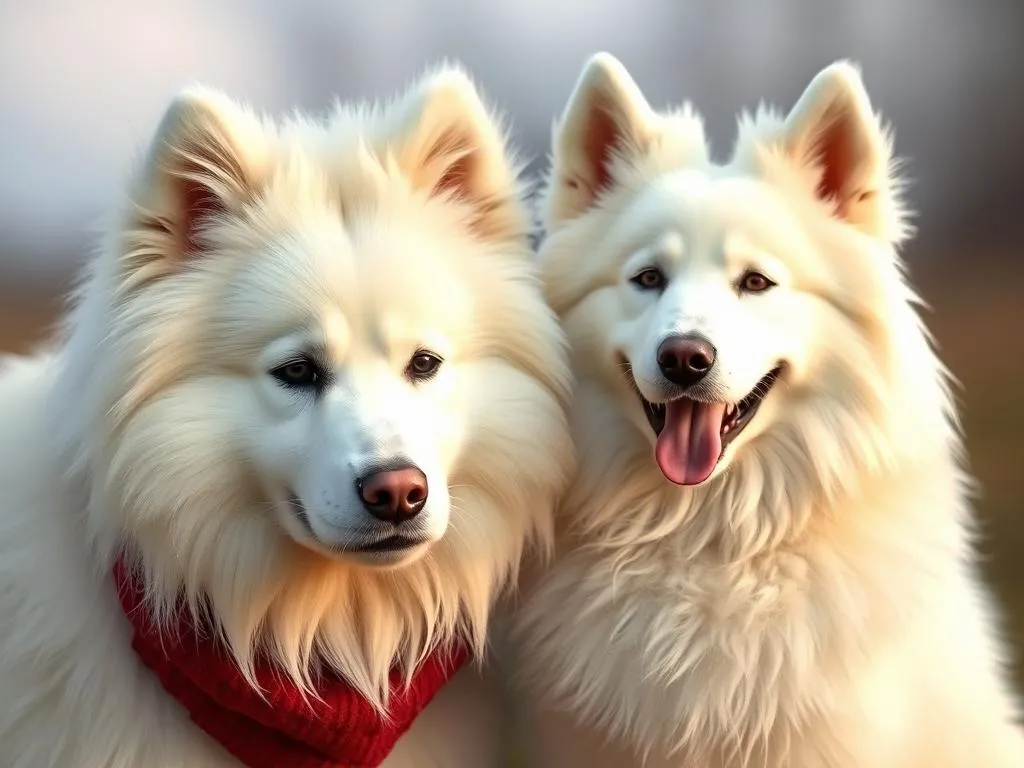
Introduction
Understanding different dog breeds is crucial for anyone considering adding a furry friend to their family. Selecting the right breed can significantly affect your lifestyle, living situation, and personal preferences. Among the popular companion dogs, the Samoyed and American Eskimo stand out for their beautiful appearance and friendly demeanor. Both breeds are known for their charming personalities and fluffy coats, making them favorites for families and individuals alike.
In this article, we will delve into a detailed comparison of the Samoyed vs American Eskimo breeds. This comprehensive analysis aims to assist potential dog owners in making informed decisions based on their lifestyle, preferences, and needs.
The Samoyed Breed
History and Origin
The Samoyed breed has a rich history that dates back thousands of years. Originating from Siberia, these dogs were primarily bred by the Samoyedic people, who relied on them for herding reindeer and pulling sleds. Their resilience in harsh climates made them invaluable companions to the nomadic tribes, and they developed strong bonds with humans.
The breed’s history is intertwined with the culture of Siberia, where their friendly disposition and loyalty were essential for survival in the frigid temperatures. Over time, Samoyeds made their way to the Western world, gaining popularity as family pets due to their affectionate nature and striking appearance.
Physical Characteristics
Samoyeds are medium to large-sized dogs, typically weighing between 35 to 65 pounds and standing about 19 to 24 inches tall at the shoulder. They are best known for their distinctive, fluffy white coats that are double-layered, providing insulation against cold weather.
Their eyes are usually dark and almond-shaped, giving them an expressive, friendly gaze. The breed’s signature feature is their “Sammy smile,” a natural curl of the lips that makes them look perpetually happy. Additionally, their tails are bushy and curled over their backs, adding to their adorable appearance.
Temperament and Behavior
In terms of temperament, Samoyeds are known for their friendly, gentle, and playful nature. They are highly social dogs that thrive on human interaction and companionship. These dogs are excellent with children and can get along well with other pets if properly socialized.
However, Samoyeds are also known for their stubborn streak, which can make training a bit challenging. Consistent, positive reinforcement methods work best for this breed. Their playful demeanor means they require regular mental and physical stimulation to keep them happy.
Health Considerations
Like many breeds, Samoyeds are prone to certain health issues. Common concerns include hip dysplasia, progressive retinal atrophy, and certain skin conditions. Regular check-ups with a veterinarian can help catch potential problems early.
The average lifespan of a Samoyed is around 12 to 14 years. To ensure a long, healthy life, owners should maintain a balanced diet, regular exercise, and routine veterinary visits.
Care and Maintenance
Grooming a Samoyed can be quite the task due to their thick, fluffy coat. They shed heavily, especially during seasonal changes, so regular brushing—at least two to three times a week—is essential to prevent matting and control loose fur.
Samoyeds require a fair amount of exercise, ideally daily walks, playtime, and mental challenges. Training should start early, focusing on socialization and basic commands to help curb any stubborn tendencies.
The American Eskimo Breed
History and Origin
The American Eskimo dog, despite its name, is not directly related to the Eskimo culture. This breed descends from the German Spitz and was initially bred as a working dog in various capacities, including herding, guarding, and performing in circuses.
Developed in the United States, the American Eskimo gained popularity in the late 19th century, especially in the circus circuit, where their intelligence and agility shone through. Over time, they became cherished family pets, known for their loyalty and protective nature.
Physical Characteristics
American Eskimo dogs come in three size variations: Toy, Miniature, and Standard. The Toy breed typically weighs between 6 to 10 pounds, while the Miniature ranges from 10 to 20 pounds, and the Standard can weigh between 25 and 35 pounds.
All three sizes share a fluffy, double coat that can be pure white or cream, with a majestic ruff around the neck resembling a lion’s mane. Their ears are erect and triangular, contributing to their alert expression, while their eyes are dark and expressive.
Temperament and Behavior
The American Eskimo is known for its intelligence, alertness, and playful nature. These dogs are highly trainable and often excel in obedience and agility competitions. They are protective of their families, making them excellent watchdogs.
Socialization is crucial for American Eskimos, as they can be reserved around strangers if not properly introduced. They enjoy being involved in family activities and require mental stimulation to prevent boredom, which can lead to destructive behavior.
Health Considerations
Similar to Samoyeds, American Eskimos are prone to certain health issues, including hip dysplasia, skin allergies, and dental problems. Regular veterinary check-ups and a good diet are essential for maintaining their health.
The lifespan of an American Eskimo typically ranges from 12 to 15 years. Preventative health measures can contribute to a longer and healthier life.
Care and Maintenance
Grooming an American Eskimo requires regular brushing to manage shedding and keep their coat in good condition. Depending on the coat type, owners may need to brush two to three times a week or more during heavy shedding seasons.
Daily exercise, including walks and playtime, is essential to keep them physically and mentally fit. They thrive in environments where they can engage in activities with their families.
Samoyed vs American Eskimo
Comparative Physical Traits
When comparing the Samoyed vs American Eskimo, there are notable differences in size and appearance. Samoyeds are generally larger, with a robust build and a longer coat, while American Eskimos come in three sizes, making them adaptable to various living situations. Both breeds share a fluffy appearance, but the Samoyed has a more pronounced ruff and a broader face.
Temperament & Behavior Comparison
Both breeds are friendly and social, but there are some differences in behavior. Samoyeds are often more playful and enjoy a more active lifestyle, while American Eskimos showcase a sharper intelligence and are more inclined to alertness, making them excellent watchdogs. Both breeds thrive on interaction and require socialization to develop well-rounded personalities.
Health and Lifespan Comparison
Both breeds face similar health concerns, including hip dysplasia and skin issues. However, the specific prevalence of these issues can vary. While the lifespan of both breeds is relatively similar, the Samoyed may be slightly more susceptible to certain eye conditions, whereas the American Eskimo may encounter more dental issues due to their smaller size.
Care Requirements
In terms of care, both breeds require regular grooming due to their thick coats. However, Samoyeds may need more frequent brushing due to their heavier shedding. Exercise needs are also comparable, but Samoyeds typically require more vigorous physical activity. Training may present challenges for Samoyeds due to their stubbornness, while the American Eskimo often excels in training due to its intelligence.
Choosing the Right Breed for You
Lifestyle Considerations
When deciding between a Samoyed vs American Eskimo, consider your lifestyle. If you lead an active lifestyle and are looking for a larger dog that enjoys outdoor activities, a Samoyed may be the right fit. However, if you prefer a smaller, adaptable dog that is easy to train and can thrive in various living situations, the American Eskimo might be the better choice.
Family Dynamics
Both breeds are family-friendly, but consider your household’s dynamics. Samoyeds are particularly good with children and can handle a more boisterous environment. In contrast, American Eskimos may require more structured socialization to ensure they are comfortable with children and other pets.
Availability and Adoption
When considering adopting a Samoyed or American Eskimo, it’s essential to research breeders and rescue organizations. Look for reputable sources that prioritize the health and well-being of their dogs. Ask questions about the dogs’ backgrounds, health screenings, and any specific care needs.
Conclusion
In summary, both the Samoyed and American Eskimo breeds offer unique qualities that can fit various lifestyles and family dynamics. Samoyeds are larger, more playful, and require more exercise, while American Eskimos are intelligent, adaptable, and come in multiple sizes.
Ultimately, the decision should reflect your lifestyle, living situation, and personal preferences. Engaging with current dog owners, visiting local shelters, and speaking with experienced breeders can provide valuable insights to help you choose the right breed for your family.




